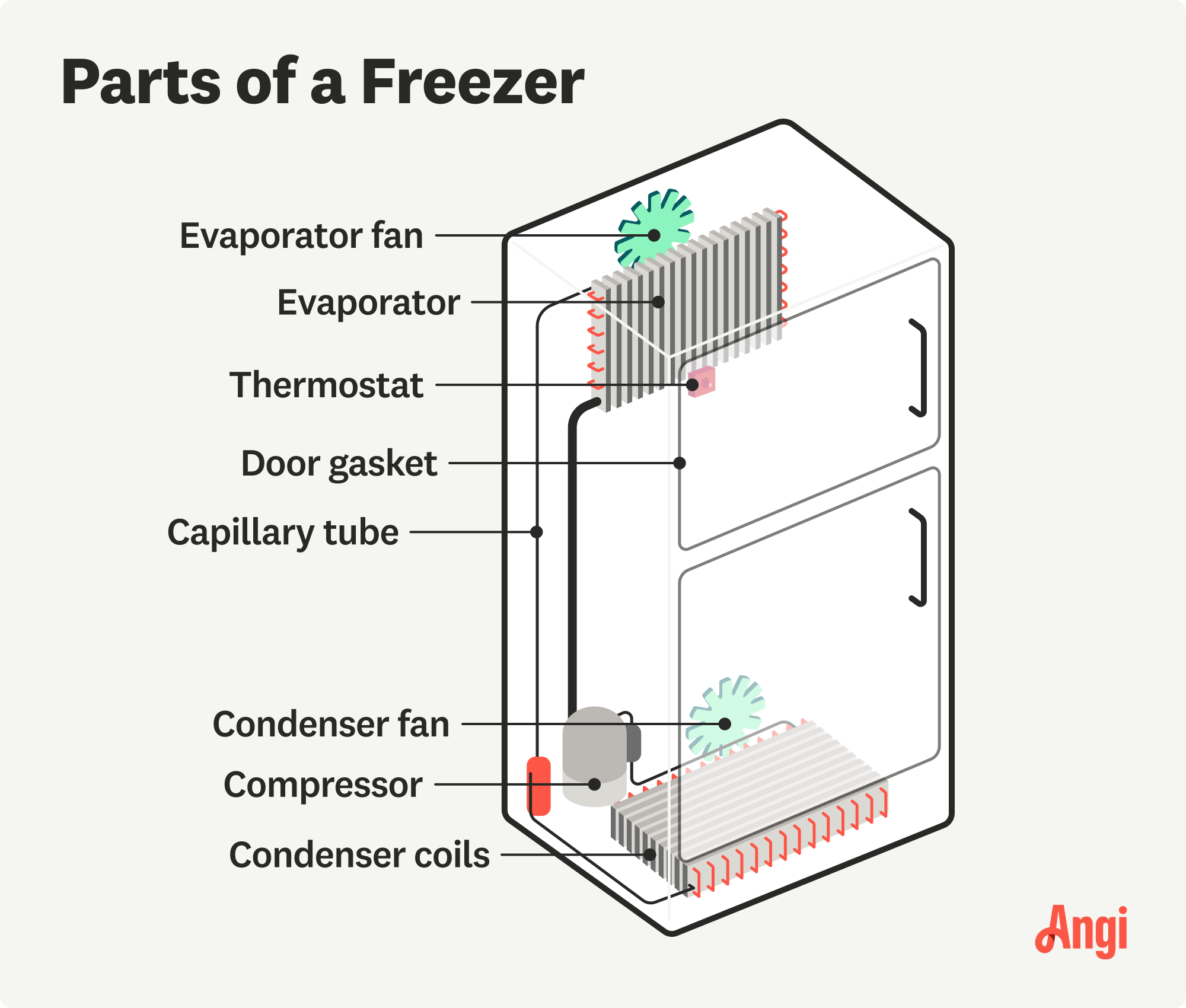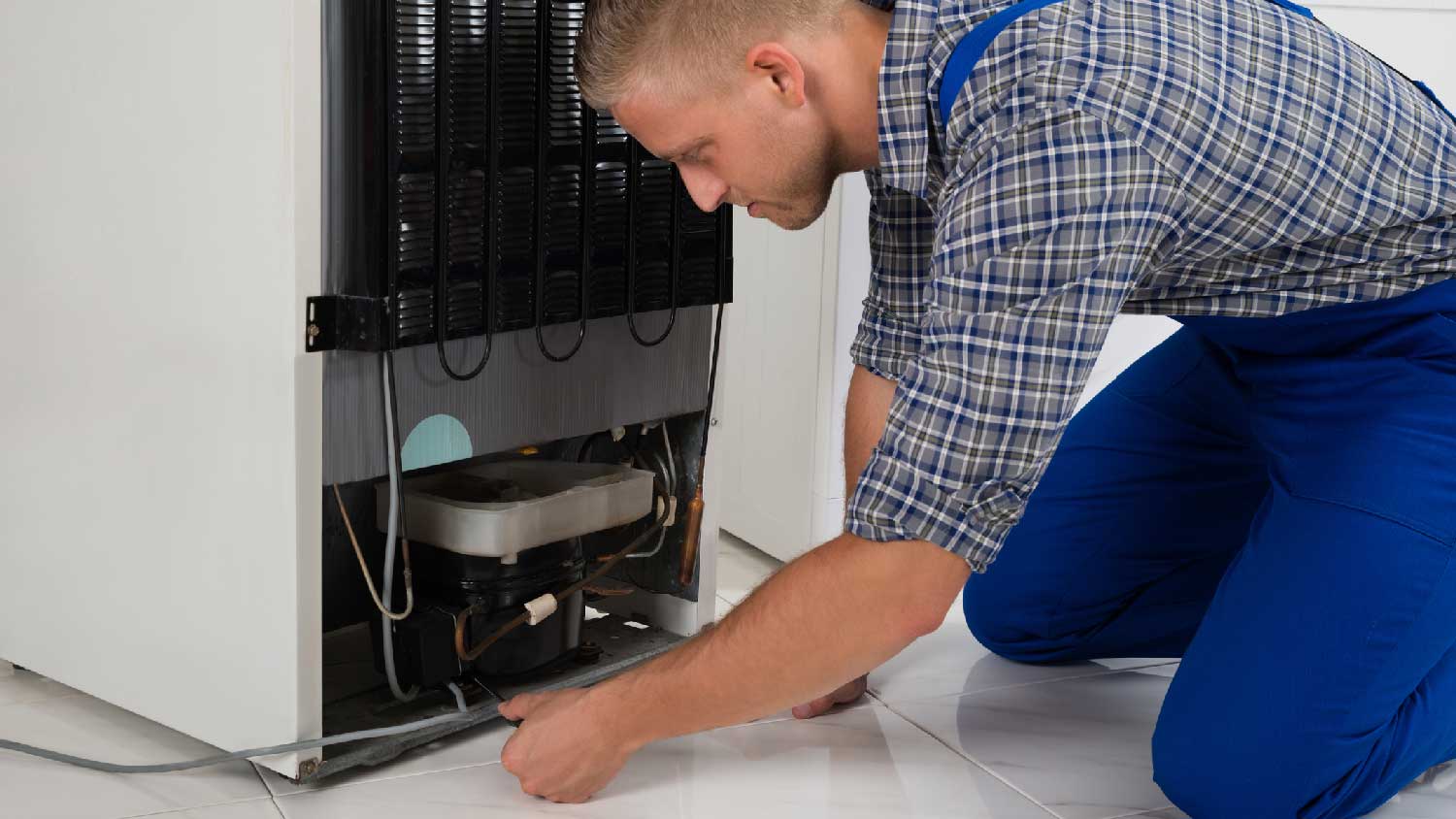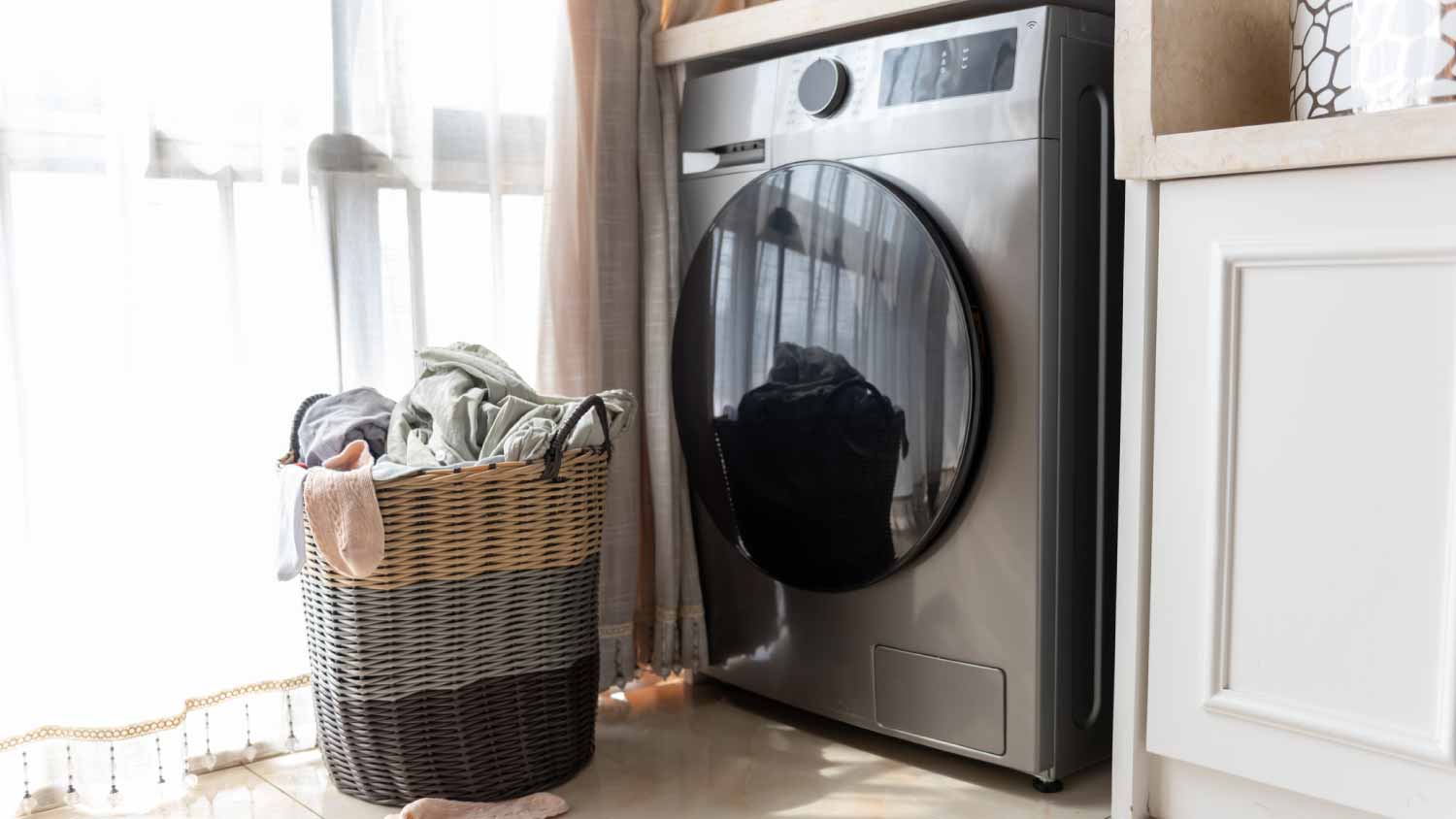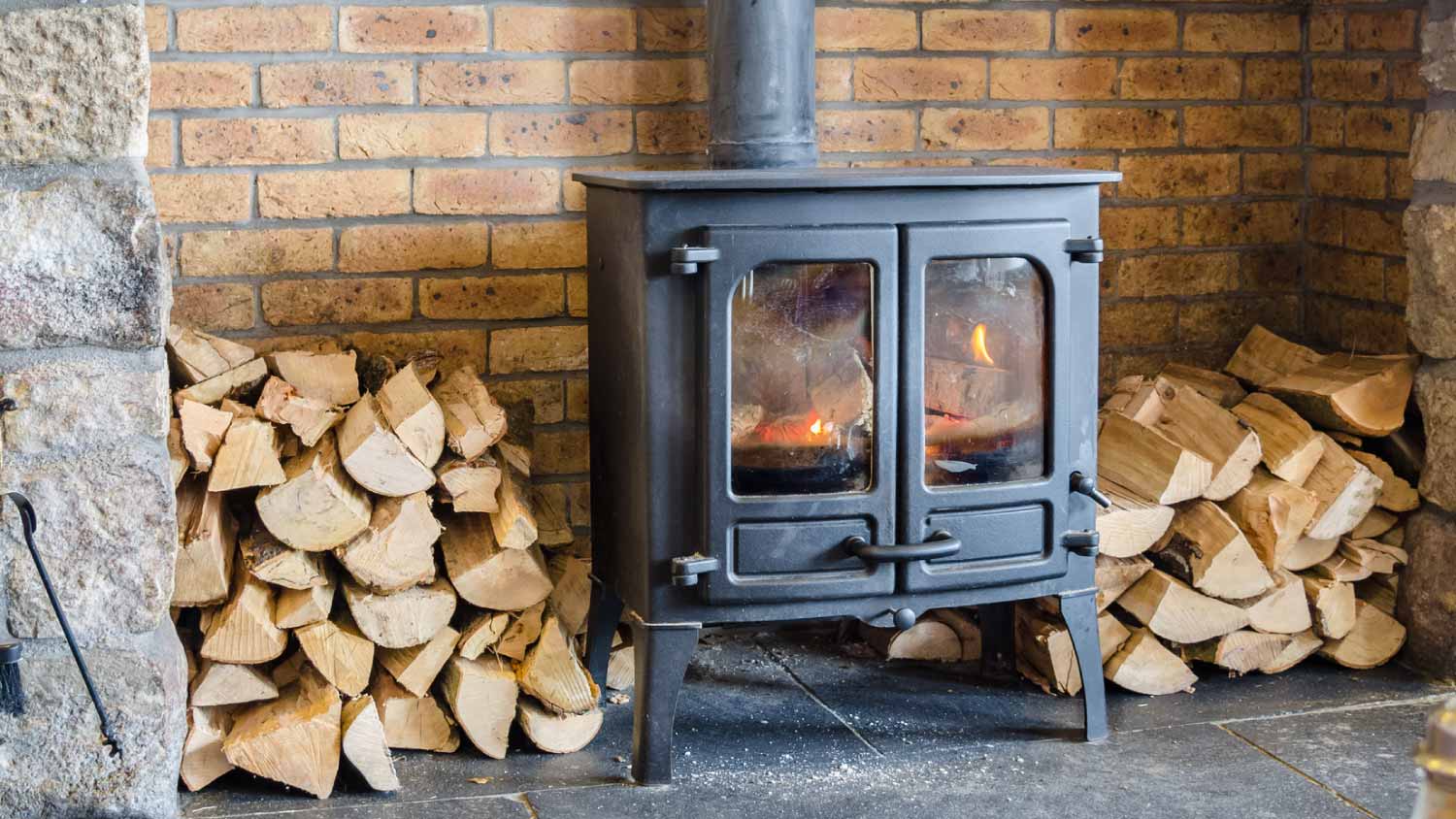Parts of a Freezer: What They Do and When to Repair Them
Know how to keep things cool


The compressor, evaporator, capillary tubes, and thermostat are key components of a freezer.
You can clean the condenser coils and door gasket yourself.
Freezers are often more complex and difficult to repair than refrigerators.
Professional freezer repair costs an average of $90 to $500.
A freezer is an essential part of any modern kitchen. Learning the parts of your freezer can help you know how to maintain your freezer and detect when something is wrong. Here’s a guide to the different parts of a freezer and when to call in a pro.
What Are the Different Parts of a Freezer, and How Do They Function?
Your freezer cycles refrigerant through its parts, including the compressor, condenser, and evaporator, to keep heat out and your food cold for long periods of time. Here are the key parts of your freezer and what they do.

1. Compressor
Located at the lower back of the freezer, the compressor is an electric pump that increases the temperature and pressure of the refrigerant so it can move through the cooling system. The compressor works with the condenser coils to move warm air out of the freezer. The compressor is essential to a freezer’s function and is often the most expensive part to replace, with a typical price range of $200 to $450.
2. Condenser Coils
Often found on the bottom or backside of the freezer, the condenser coils move the refrigerant to the next stage of its cycle. The compressor pushes the pressurized refrigerant to the condenser coils, turning it from a vapor into a liquid through the heat transfer process. Condenser coils can cost anywhere from $100 to $440.
3. Condenser Fan
The condenser fan sits right behind the condenser coils and draws cool air over them. The fan keeps the condenser and compressor from overheating and helps transfer warm air out of the freezer. It’s important to fix a broken condenser fan motor promptly, as the compressor can overheat without it, leading to expensive repairs. A condenser fan typically costs $200 to $350.
4. Capillary Tube
The capillary tube is a small spiral of wire that causes a large drop in the refrigerant’s pressure to lower the temperature of the refrigerant. It transforms the refrigerant from a liquid to a vapor. The cost of a capillary tube ranges from $50 to $150.
5. Evaporator
The evaporator absorbs heat and converts the refrigerant back to its low-pressure form. It creates a freezing cold vapor that assists in the long-term storage of frozen food. The refrigerant's final destination is the evaporator; after that, it travels back to the compressor for the start of the freezing cycle. Evaporators cost $150 to $250.
6. Evaporator Fan
The evaporator fan sits above the evaporator coils and draws cold air over the coils to circulate it through the freezer. Whether you have an upright or chest freezer, the evaporator fan motor is essential, as it distributes cold air and removes warm air. Evaporator fan motors cost $100 to $300 depending on the model.
7. Door Gasket

The door gasket is the rubber tubing that creates an airtight seal when the freezer door is closed. It prevents warm air from entering your freezer and locks cold air inside. A gasket costs around $50, depending on your freezer’s make and model, but sometimes all it needs is realignment or cleaning.
8. Thermostat
The thermostat regulates the freezer’s temperature with its electronic control and sensing device. The thermostat controls the compressor, evaporator fan motor, and the condenser fan motor. If you need to replace the thermostat, it can cost $100 to $440.
9. Start Relay
The start relay provides power to the compressor, making it a critical component. The start relay plugs into the compressor. It typically costs $50 to $200 to repair a start relay.
How to Know When Parts of a Freezer Need Repair

If you notice your freezer is not freezing or is working harder than usual to stay cool, one of its key parts could be the culprit. Learn what to watch for with each part and what to do next.
Compressor
You may need to repair or replace your compressor if you hear unusual noises such as thumping in your freezer, notice your freezer running constantly but not reaching the desired temperature, or see moisture on the outside of your freezer. Because the compressor is an expensive and complex part, it’s best to leave the repair to a pro to avoid damaging your freezer further.
Condenser Coils
Your condenser coils might need a cleaning if you hear unusual loud noises such as humming, gurgling, or clicking. They might also need a clean if the freezer isn’t maintaining the proper temperature. Dirty condenser coils can block airflow, causing your appliance to work overtime. Clean the coils by turning off your freezer at the power source and vacuuming with an attachment or wiping the coils with a soft cloth.
Condenser Fan
A broken condenser fan prevents your freezer from staying cold and can cause damage to your compressor if you don’t get it fixed. Condenser fans are difficult to access and repair, so it’s best to contact a pro.
Capillary Tube
When the capillary tube is blocked, the freezer has to work harder to move the refrigerant through the system because of the high pressure. Turn off the power to your freezer, then check to see if the capillary tube is blocked by ice, debris, or residue. If the problem is ice, apply heat to the area with a hairdryer. If it’s dirty, clean it with a soft cloth. Turn the power back on and see if the issue is resolved. If it isn’t, call in a pro.
Evaporator
Your evaporator might not be working properly if your freezer begins to defrost. A dirty evaporator coil can release warm air. You can clean it by turning off the power to your freezer and wiping it down with a soft cloth. If an evaporator coil is damaged, coolant might leak out. If you suspect damage, contact a repair pro.
Evaporator Fan
If you notice cold air near the coils but not in the food storage area, the evaporator fan motor might be to blame. To check the motor, open your freezer door and hold down the freezer door switch to see if the fan turns on. If it doesn’t run, contact a pro to fix it.
Door Gasket
If your freezer isn’t holding the proper temperature, your door gasket might lack a strong seal. Open the door and inspect the gasket for damage, mold, or misalignment on the door frame. You can also shut a piece of paper in the freezer door and then try to pull the paper out. If the paper comes out easily, you might have a seal problem. Clean the edge if there is mold. Readjust the gasket if it seems out of place. Or replace the gasket altogether, if it’s damaged.
Thermostat
The thermostat is essential to maintaining the ideal freezer temperature. If you notice inconsistent temperatures inside your freezer or an unresponsive thermostat, it’s time to call in a trained pro to help.
Start Relay
If you hear clicking sounds from the freezer, notice a lack of the usual compressor humming sound, or your freezer keeps tripping the breaker, the start relay might be the issue. Contact a repair pro, as start relays are electrical components that require special training to fix or replace.
DIY Freezer Part Repair vs. Hiring a Pro
While you can clean the condenser coils or door gasket yourself, replacing electrical components like the evaporator fan motor and thermostat are a little trickier and require special training. Tackling these complex components yourself can lead to safety risks and damage other parts of your freezer, leading to further expenses. It’s best to hire a fridge repair pro near you for repairing or replacing the electrical parts of a freezer. The cost to hire a freezer repair pro ranges from $90 to $500, but it’s often worth the investment to properly fix your appliance and keep your food safe.



.jpg?impolicy=leadImage)

- Appliance Repair Companies
- Washing Machine Repair
- Dryer Repair
- Refrigerator Repair
- Dishwasher Repair
- Oven Repair
- Wood & Pellet Stove Repair
- Freezer Repair Services
- Wood Stove Services
- Gas Stove Repair
- Emergency Appliance Repair Companies
- Ice Maker Repair
- Gas Appliance Repair
- GE Appliance Repair
- GE Refrigerator Repair
- GE Dryer Repair
- GE Dishwasher Repair
- GE Washing Machine Repair
- Samsung Appliance Repair
- Samsung Refrigerator Repair
- Samsung Dryer Repair
- Samsung Washer Repair
- Samsung Dishwasher Repair
- Samsung Oven Repair
- Whirlpool Repair
- Whirlpool Refrigerator Repair
- Whirlpool Washer Repair
- Whirlpool Dryer Repair
- Whirlpool Oven Repair
- Maytag Appliance Repair
- Maytag Refrigerator Repair
- Maytag Washer Repair
- Maytag Dryer Repair
- Maytag Dishwasher Repair
- Kitchenaid Appliance Repair
- Kitchenaid Oven Repair
- Kitchenaid Refrigerator Repair
- Kenmore Appliance Repair
- Kenmore Dishwasher Repair
- Kenmore Washer Repair
- Kenmore Dryer Repair
- LG Refrigerator Repair
- Bosch Appliance Repair
- Kenmore Refrigerator Repair
- LG Appliance Repair Services
- GE Microwave Repair
- Electrolux Appliance Repair
- Electrolux Washer Repair
- Kitchenaid Dishwasher Repair Services
- Wood Stove Inspection
- Dishwasher Installation
- Trash Compactor Repair
- Why Your Freezer Is Not Freezing: 8 Potential Causes & Solutions
- 9 Reasons Why Your Freezer Is Leaking (and How to Fix It)
- Why Is My Freezer Frosting Up? Here Are 10 Common Reasons and Solutions
- Who Fixes Freezers? Who to Call to Fix the Freezer
- 10 Steps to a Well-Maintained Fridge and Freezer
- What Is the Ideal Freezer Temperature?
- What Is a Garage-Ready Freezer?
- 11 Reasons Your AC Is Blowing Hot Air
- Evaporator Coil vs. Condenser Coil: How to Tell the Difference
- Refrigerator Constantly Running: Reasons and Solutions










